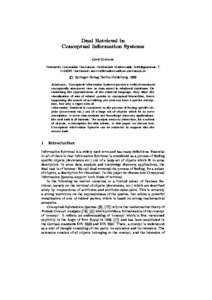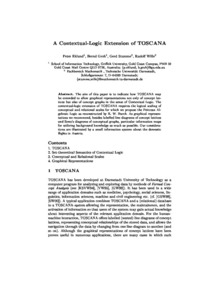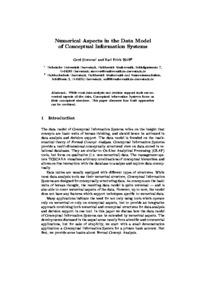Search
Now showing items 1-10 of 55
Aufsatz
 Conceptual structures represented by conceptual graphs and formal concept analysis
Conceptual structures represented by conceptual graphs and formal concept analysis
(1999)
Conceptual Graphs and Formal Concept Analysis have in common basic concerns: the focus on conceptual structures, the use of diagrams for supporting communication, the orientation by Peirce's Pragmatism, and the aim of representing and processing knowledge. These concerns open rich possibilities of interplay and integration. We discuss the philosophical foundations of both disciplines, and analyze their specific qualities. Based on this analysis, we discuss some possible approaches of interplay and integration.
Aufsatz
 Conceptual information systems discussed through an IT-security tool
Conceptual information systems discussed through an IT-security tool
(2000)
Conceptual Information Systems are based on a formalization of the concept of "concept" as it is discussed in traditional philosophical logic. This formalization supports a human-centered approach to the development of Information Systems. We discuss this approach by means of an implemented Conceptual Information System for supporting IT security management in companies and organizations.
Aufsatz
 Acquiring expert knowledge for the design of conceptual information systems
Acquiring expert knowledge for the design of conceptual information systems
(1999)
Conceptual Information Systems unfold the conceptual structure of data stored in relational databases. In the design phase of the system, conceptual hierarchies have to be created which describe different aspects of the data. In this paper, we describe two principal ways of designing such conceptual hierarchies, data driven design and theory driven design and discuss advantages and drawbacks. The central part of the paper shows how Attribute Exploration, a knowledge acquisition tool developped by B. Ganter can be ...
Aufsatz
 Dual retrieval in conceptual information systems
Dual retrieval in conceptual information systems
(1999)
Conceptual Information Systems provide a multi-dimensional conceptually structured view on data stored in relational databases. On restricting the expressiveness of the retrieval language, they allow the visualization of sets of realted queries in conceptual hierarchies, hence supporting the search of something one does not have a precise description, but only a vague idea of.
Information Retrieval is considered as the process of finding specific objects (documents etc.) out of a large set of objects which fit to ...
Aufsatz
 A contextual-logic extension of TOSCANA
A contextual-logic extension of TOSCANA
(2000)
The aim of this paper is to indicate how TOSCANA may be extended to allow graphical representations not only of concept lattices but also of concept graphs in the sense of Contextual Logic. The contextual-logic extension of TOSCANA requires the logical scaling of conceptual and relatioal scales for which we propose the Peircean Algebraic Logic as reconstructed by R. W. Burch. As graphical representations we recommend, besides labelled line diagrams of concept lattices and Sowa's diagrams of conceptual graphs, particular ...
Aufsatz
 Mining minimal non-redundant association rules using frequent closed itemsets
Mining minimal non-redundant association rules using frequent closed itemsets
(2000)
The problem of the relevance and the usefulness of extracted association rules is of primary importance because, in the majority of cases, real-life databases lead to several thousands association rules with high confidence and among which are many redundancies. Using the closure of the Galois connection, we define two new bases for association rules which union is a generating set for all valid association rules with support and confidence. These bases are characterized using frequent closed itemsets and their ...
Aufsatz
 Numerical aspects in the data model of conceptual information systems
Numerical aspects in the data model of conceptual information systems
(1999)
While most data analysis and decision support tools use numerical aspects of the data, Conceptual Information Systems focus on their conceptual structure. This paper discusses how both approaches can be combined.
Aufsatz
 CEM - visualization and discovery in Email
CEM - visualization and discovery in Email
(2000)
This paper presents a lattice-based visual metaphor for knowledge discovery in electronic mail. It allows a user to navigate email using a visual lattice metaphor rather than a tree structure. By using such a conceptual multi-hierarchy, the content and shape of the lattice can be varied to accommodate any number of queries against the email collection. The system provides more flexibility in retrieving stored emails and can be generalised to any electronic documents. The paper presents the underlying mathematical ...
Aufsatz
 Reuse in the development process of TOSCANA systems
Reuse in the development process of TOSCANA systems
(1999)
TOSCANA is a graphical tool that supports the human-centered interactive processes of conceptual knowledge processing. The generality of the approach makes TOSCANA a universal tool applicable to a variety of domains. Only the so-called conceptual scales have to be designed for new applications. The presentation shows how the use of abstract scales allows the reuse of formerly defined conceptual scales. Furthermore it describes how thesauri and conceptual taxonomies can be integrated in the generation of conceptual scales.










